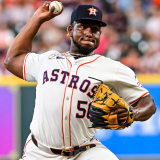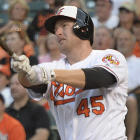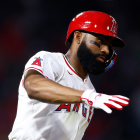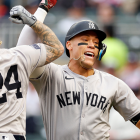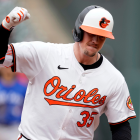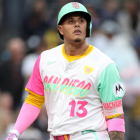You'd think it would've been good timing on Mark Trumbo's part. The veteran slugger last season for the Orioles cracked a majors-leading 47 home runs just in time to hit the free-agent market. Under normal circumstances, that kind of walk-year power display would beget one of the biggest free agent contracts of that particular offseason. Trumbo, though, remains unsigned as we head toward the new year, and if the rumors are any guide then nothing seems particularly close to materializing for him.
That's no accident. Yes, Trumbo can help a number of teams next season in beyond, but those same teams probably aren't going to be willing to pay a premium for a player they see as being flawed and limited. As such, Trumbo's next contract almost certainly won't crack $50 million, despite some expectations to the contrary. That's likely the case for a number of reasons ...
1. He doesn't do much at the plate besides hit for power.
While Trumbo's home run proclivities are both valuable and duly noted, he doesn't do much else. For his career, he's batted .251 for his career (.256 last season) and drawn unintentional walks in just 6.2 percent of his plate appearances. Framed another way, Trumbo's a hitter who strikes out roughly four times as often as he works the pitcher for a walk. The result of all that is career on-base percentage of .303, which is not an acceptable figure for a bat-first player like Trumbo. To his credit, Trumbo's gradually done a better job of laying off pitches outside the zone, and he's registered a somewhat more acceptable .316 OBP in each of the last two seasons. Still, he creates far too many outs at the plate. Yes, he hit 47 homers in 2016, but he also made 10 times as many outs -- 470. That's ... a lot.
2. Last year's homer total was out of step with his established level of performance.
Those 47 homers happened, and there's no denying bald reality. However, teams may fade Trumbo a bit because he hasn't put up those kinds of numbers before. On that point, his homer total in 2016 is almost 40 percent higher than his previous career best of 34 with the Angels in 2013. One specific cause for concern is that Trumbo in 2016 homered on a remarkable 24.6 percent of his fly balls. That's well north of his career mark of 19.3 percent. So, skills growth or aberrant spike? Trumbo has increased his fly ball percentage over the years and last season showed an improved knack for hard contact. The simple reality, though, is that it's hard to sustain something like homering on a quarter of the balls you hit in the air. Regression on the home run front seems very likely for Trumbo.
3. Trumbo's on the wrong side of age 30.
An obvious point, but it's one worth noting: Trumbo in 2017 will be going into his age-31 campaign. Late-career spikes are always possible -- Trumbo likely enjoyed one this past season -- but players generally begin declining in their late 20s. There's also some evidence that players these days are peaking earlier. So it's not just the likelihood of power regression that must be taken into account with Trumbo. It's also that age-related decline may become a more of a factor in 2017.
4. When he's in the outfield, he gives back a lot of runs.
How do you hit 47 runs but put up a middling WAR of just 1.6 in the same season? In large part, you "achieve" such a thing by being a bad fielder. Trumbo in the outfield is just such a thing. The advanced metrics, the eye test, and the scouting reports all agree that Trumbo is badly miscast as an outfielder. The team that signs him in no way should do so under the impression that he can spend meaningful innings in left or right field. Trumbo figures to be an acceptable first baseman, yes, but it's worth noting that he hasn't spent a full season at first base since 2013. Also, Trumbo provides negative value on the bases. He's stolen just four bases in seven attempts over the last half-decade, and for his career he's taken the extra base just 32 percent of the time.
5. Don't forget the qualifying offer.
Trumbo of course turned down a qualifying offer from the Orioles, and that means if he signs elsewhere then his new team will forfeit a high draft pick -- a first-round pick in most instances. That team loses not only the pick itself but also the bonus pool money associated with that selection. There's a reason that the MLBPA pushed hard to weaken the free-agent compensation system in the new CBA, and that's because the system that expires this offseason is excessively punitive. The end result is lessened demand for a free agent's services. That's especially the case with a mid-line free agent like Trumbo. And, yes, for reasons laid out herein, Trumbo is indeed a midline free agent.
So Trumbo's expectations are not likely to be met this offseason. He may wind up, like others dinged by the qualifying offer, signing a one-year pillow contract that allows him to go out and prove he's established a new level of performance. In the past, that's worked out pretty well for the likes of Nelson Cruz and, just this winter, Ian Desmond and Dexter Fowler. Trumbo on a short-term commitment as a first baseman or DH is fine. Trumbo as an outfielder on a four- or five-year pact is a potential boondoggle. Expect the market to agree with that assessment.









